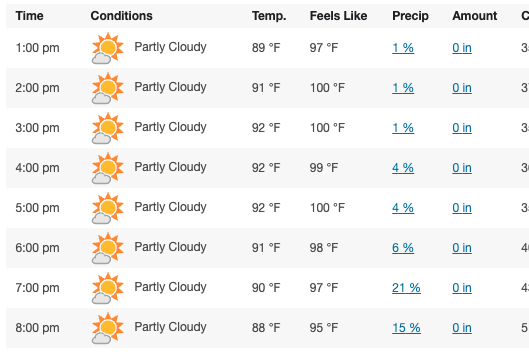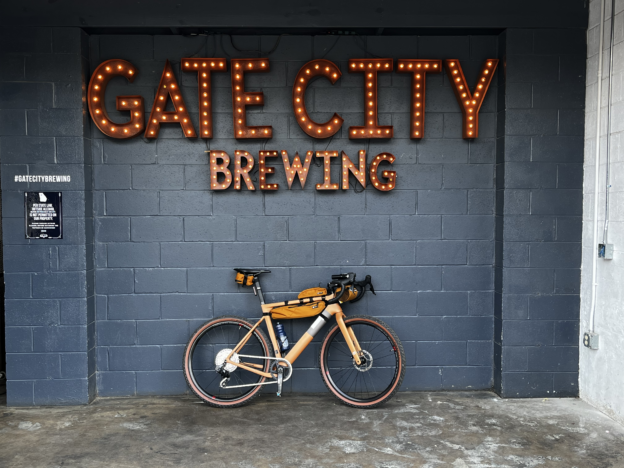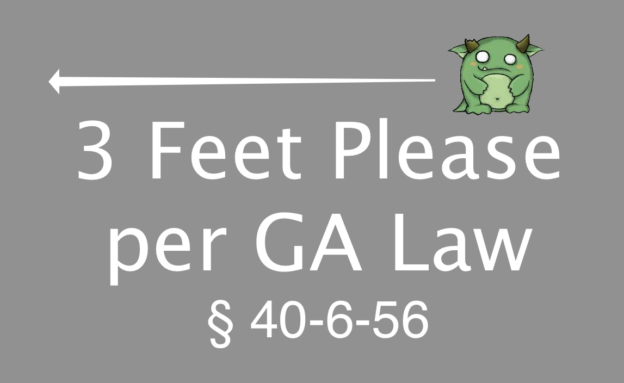Despite being a cyclist, and outspoken cycling advocate, I really do understand the challenges, both real and emotional that drivers are faced with when approaching a cyclist or a group of them and feeling the need to pass. Today, in a conversation about a close encounter, I was asked to provide a bit of information about how to do this.
I apologize in advance, because this is not a short answer :(. I am going to tackle this from two directions, first, we will look at the “letter of the law” answer, and then we will circle back to a, perhaps, more pragmatic answer that I think suits everyone involved a little better, even if it is not an answer that makes anyone ‘happy’.
I guess a little background is required here. Georgia bicyclists generally have the same rights, and same duties, as drivers of motor vehicles, with certain specified exceptions. In addition, Bicycles are to ride as near to the right side of the roadway as practicable, except when (1) turning left, (2) avoiding hazards to safe cycling, (3) the lane is too narrow to share safely with a motor vehicle, (4) traveling the same speed as traffic (5) passing a standing vehicle or one proceeding in the same direction, or (6) there is a right turn only lane and the person riding the bicycle is not turning right. People on bicycles must ride in the same direction as the flow of traffic. People over the age of 12 are not legally permitted to ride on the sidewalk. Bike lanes are for the exclusive use of Georgia bicyclists, but a person on a bicycle is not required to use the bike lane unless required to do so by a local governing authority. Where a bicycle lane is provided on the roadway, the operator of a motor vehicle shall yield to a person operating a bicycle in a bicycle lane. The operator of a motor vehicle, when overtaking and passing a bicycle that is proceeding in the same direction on the roadway, shall leave a “safe distance” between the motor vehicle and the bicycle. “Safe Distance” is defined by law as meaning not less than three (3) feet. It is worth noting that the text of that law makes no distinction between a bike in the lane and a bike in a bike lane. 3 feet of space is required in either case. Bicyclists may not ride more than 2 abreast on the road.
As a side note, there is no requirement for single file in Georgia law, and though many people think single file should be required, it really is not a good idea.
Letter of the Law
Georgia law is actually pretty clear on how bicycles should use the road, as demonstrated above. It boils down to keep right, ride no more than two abreast and follow basic road rules.
Passing a cyclist or a group, is a little less clear. What the law states is that 3′ feet is the minimum space to give when passing, more is advised. In addition, though it takes looking at 2 additional GA motor vehicle statutes to determine this, it is in fact legal to pass bikes on a double yellow, with certain restrictions. First, in so doing the driver absorbs ALL of the liability of a crash caused by their actions. What this means is that if there is not visibility to allow time for the pass to be completed before being within 200 feet of an oncoming car, it is not legal. In addition, the same as any other pass, you must not exceed the speed limit, or engage in reckless practices to accomplish the pass. Second, at no time during the pass may you be within 3 foot of any rider you are passing.
What does this mean in application? well, it means that in order to execute a legal pass, a driver must:
* make sure the passing space is clear.
* signal intent to change lanes.
* accelerate to passing speed without exceeding the speed limit.
* change lanes, providing AT LEAST 3 feet to all of the bicycles to be passed.
* return to the travel lane before being within 200 feet of oncoming traffic.
That is the process following the letter of the law, and in the case of some of these roads, an impossible task.
Pragmatic Approach to Passing
Alright, so we’ve pointed out the letter of the law, and I think we all understand that it is inconvenient, because slowing down, and traveling at the 15-30mph the bikes are traveling is bloody inconvenient.
So, let’s be pragmatic, and discuss a few things surrounding how to pass, and why cyclists do what they do. Let us start with something that I find to be one of the biggest bones of contention, and by far the most misunderstood behavior on both sides. Riding double file, and taking the lane. As a driver, seeing those bikes side by side is frustrating, because they are taking up so much of the road. When there is a group of them, depth perception tricks make it look like they are 3-4 wide, and they are making it harder to pass. At least that is the perception.
Perception is not reality here though. There are two dynamics in play here, and both are perceptual problems because what a driver ‘thinks’, and what is ‘true’ are disconnected. Why? because a driver perceives the bikes as standing still, rather than moving, and thus misjudges the distances travelled, and compounding matters, in a single file situation, they will see a space that doesn’t actually exist to pass in.
I am sorry but we are going to take a step to the left here and do a bit of math.
The average width of a cyclist is ~30 inches (2.5 feet).
The average width of a vehicle in America is 8 feet. The narrowest car on the roads, the US market SMART ForTwo is almost 6 feet mirror to mirror.
The width of a lane on many of the surface streets of north Fulton? 10.5 feet.
So, the average car at 8 feet, the average rider at 2.5 feet, a minimum 3 foot buffer between them, and another 1.5 feet of safe space from the right edge of the road. Well, 15 feet well exceeds the lane width of 10.5 feet. What this means is that even single file, it is impossible for a bike and a car to legally share a lane in a passing situation. A car MUST depart the lane to legally pass a bike.
Once we wrap our heads around that, all of this gets easier, because now we understand that the goal is to be across the center line for the shortest amount of time, so we also want the line of bicycles to be the shortest possible. And that means, double file, which cuts the length of the line in half ( each bike is 6 feet long, with a bit of padding ), and subsequently reduce the time and distance required to pass by about 30% ( it fluctuates on number of bikes, but that’s a safe rough number), and having to go fully into the other lane, versus partly into the other lane is irrelevant, because either way, you are pushing oncoming traffic into a panic situation if you are not prudent about it.
So, the pragmatic approach?
* slow down and wait for a safe opening.
* signal intent to change lanes / pass
* accelerate to no more than 10mph over the posted limits.
* change lanes, providing AT LEAST 3 feet to all of the bicycles to be passed.
* return to the travel lane before being within 200 feet of oncoming traffic.
Note how similar the two are? the difference is your expectations of the cyclists, and understanding that they are not ‘being jerks’ riding two abreast but are in fact trying to make it easier and safer for you to pass.
Notes of Caution
In both cases, there are some things to think about that are MAJOR contributors to bike/car crashes. If you are within .5 miles of your next turn. Do not pass, and then brake and turn into the path of cyclists ( this is known as a “right hook” and accounts for 25% of all bike/car crashes, and an even higher rate for pedestrians ). When approaching an intersection, do not pass going into the intersection as you will be ‘brake checking’ the cyclists you just passed. Round-a-bouts. Do NOT pass late into a round-a-bout. Even if you are driving a Ferrari, you cannot transit a round-a-bout faster than a bike at speed. This is a new enough phenomena with wide installation of round-a-bouts in the US that the data is not there yet, but anecdotally these numbers are rising fast.
Cyclists Helping Out
Many groups WILL single file, and use any shoulder space available to make passing easier when opportunities present. Many will use bike lanes for the same reasons. Many will try to give slowed traffic opportunities to get around at stop signs and other points along a ride.
Examples
Hardscrabble Rd from King to Etris.
This is a bit of road that is seeing more and more usage by bikes in the area. Many used King Rd to Cox Rd in the past, however the addition of the bike lanes on Hardscrabble has redirected much of the traffic. Many of the groups traversing this stretch of road are traveling far faster than the typical driver realizes ( as an example, the “slow” group on Monday nights traverses this at upwards of 22mph, with the “fast” groups at 28-30mph ). They are however traveling single file with the exception of the round-a-bout at Chaffin, and taking the lane to turn left onto Etris Rd.
Mayfield Rd from Charlotte Dr to Canton St
This section of road is in extremely bad condition from Charlotte to Bethany Rd. Bikes cannot safely use the far right of the road. There is poor visibility from the uphill before Freemanville Rd until the new round a bout at Bethany Rd. There is no safe place to pass, though we see it happen often. In nearly every case, the bikes will arrive at the Bethany Rd intersection at the same time as the vehicle that passed them. After Bethany Rd, there is a bike lane, and the lane width goes from 10.5 to 11 feet, with good visibility, thus passing is rarely an issue.
Conclusions
The biggest challenge in this discussion is the mistaken belief that a car ‘has’ to pass the bikes and that the pass will somehow save travel time. The sad truth is that the savings is measured in seconds, at best.
To give one last example: my commute to/from work is 11 miles, against the flow of traffic. It takes an average of 36 minutes door to door via car. It takes an average of 40 minutes via bike. I regularly see cars that ‘pass’ me at the stop lights immediately following the pass. The gains are so negligible that they are statistically irrelevant. The only places the passes make sense are exactly where they are legal and advisable, open stretches of road, with good visibility.
Closing
I apologize a bit for the wall of text, but I wanted to give as much detail as possible, knowing full well, that for the most part it is not what drivers really want to hear. There is no great answer here in a car centric world. I can only ask that people actually look at the time the real average speeds they travel, not the speeds they think, and realize just how little slowing down behind a bike or group for bikes really matters.


